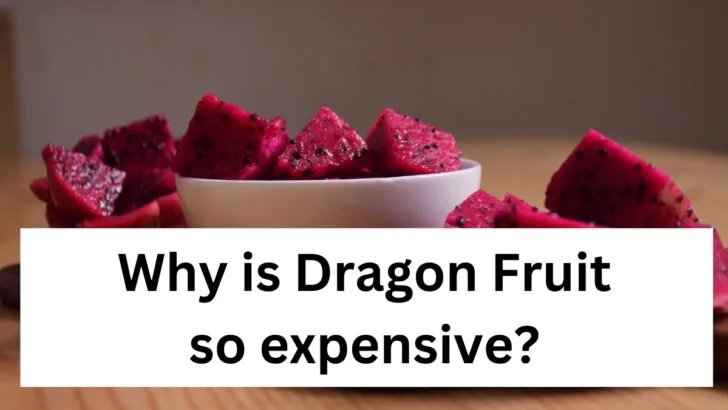Dragon fruit is an exotic fruit with a cringingly high price tag. Although it doesn’t interfere with sales, many can’t help but wonder why it’s so expensive.
Dragon fruit is expensive because it’s an exotic fruit, has limited growing locations, is an imported good, is difficult to grow, and produces a small yield. You can save money on dragon fruit by buying it frozen, in season, in bulk, and when it’s on sale.
The price of dragon fruit can greatly vary depending on the season that you are buying in, as well as the location where the fruit was produced.
How Much Does Dragon Fruit Cost?
There are few fruits that fetch as high of a price in the grocery store as dragon fruit. This exotic and delicious fruit has quite a bit of hype around it, and its popularity has skyrocketed in recent years.

Dragon fruit sold in the United States is generally priced between $5 and $6 per piece and weighs between 300 and 400 grams. The cost of dragon fruit can fluctuate throughout the year, with sales prices being more reasonable.
Buying dragon fruit at certain stores out of season can result in a ridiculous price tag that is as high as $10+ each. You may be able to find package deals such as 4 dragon fruits for $20 in some cases, but you should expect the price to be high regardless.
Reasons Why Dragon Fruit is So Expensive
The price of a single dragon fruit can be frustratingly high for a lot of shoppers, but that rarely stops them from buying them. However, it’s important to understand exactly why dragon fruit is so expensive in the first place.

Exotic Fruit
The bottom line is that dragon fruit is a unique exotic fruit, which immediately raises its price tag exponentially.
This spiky fruit looks weird, tastes great, and ticks every box for an appetizing exotic fruit at a fancy dinner party.
Limited Growing Locations
Unlike other common tropical fruits such as bananas, dragon fruit is much more limited when it comes to growing locations. The climate conditions must be stable for the crop to bear good fruit.
There are only a few climate zones in the world that are suitable for growing dragon fruit, and the ideal temperature conditions should primarily be 85 to 95°F. These are the countries that produce the most dragon fruit internationally:
- Vietnam
- Thailand
- Malaysia
- The Philippines
Since dragon fruit has become increasingly popular, many other countries, including the United States, are attempting to capitalize on this exotic fruit.
However, given the climate requirements to grow dragon fruit, the farming locations are limited to only a few warm and tropical regions in the country, found primarily in California and Florida.
Imported Good
Given that the bulk of the dragon fruit sold around the world only comes from a handful of countries in South East Asia, virtually all fruits are imported. This factor alone raises the price of dragon fruit dramatically.
To start, import taxes are applied to all exotic fruits, particularly those that are rare items such as dragon fruit. The import fees of dragon fruit are even higher than most other goods due to the shipping process being rather delicate.
Dragon fruit is a premium import fruit that needs to be handled with care in order to retain its high value. The additional handling and processing further increase the import fees of dragon fruit.
Difficult to Grow
Growing dragon fruit is more challenging and complicated than other types of fruit. This is a high-risk, high-reward fruit that requires an initial investment before profits can be seen.
It takes a dragon fruit tree roughly 2 years to grow before it will even start growing fruit. This implies that farmers have to put in at least 3 or 4 years of work before they can start profiting from their investment.
Small Yield
To make matters even more complicated, once dragon fruit trees do start bearing fruit, the yield is often quite low. Dragon fruit trees are not nearly as plentiful as other tropical fruits, which results in a smaller supply of fruit at the end of the season.
High Demand
Dragon fruit is an incredibly popular fruit due to its delicious flavor, various health benefits, and exotic nature. This ultimately creates a huge demand for dragon fruit, with a lot of shoppers eager to buy.
However, the high demand for the fruit can barely be met due to a lack of supply. Since dragon fruit trees produce such a small yield when they are grown, there is simply not enough fruit to go around, increasing the price of dragon fruit even further.
How to Save Money When Buying Dragon Fruit
Let’s face it, dragon fruit is simply too expensive for most of us to buy on every grocery run. With that said, given that $6 to $10 can be the price for just a single dragon fruit, many people prefer to avoid buying it on principle.
Luckily, there are some ways to save money when buying dragon fruit, so that you can enjoy this exotic fruit without breaking the bank.
- Buy frozen dragon fruit
- Buy dragon fruit when it’s in season
- Buy dragon fruit in bulk
- Wait until dragon fruit is on sale (June through September)
Key Takeaways to Why Dragon Fruit is So Expensive
Dragon fruit is expensive because it’s an exotic fruit, has limited growing locations, is an imported good, is difficult to grow, produces a small yield, and is high in demand.
Dragon fruit costs an average of $5 to $6 per piece and weighs roughly 300 to 400 grams.
You can save money on dragon fruit by buying it frozen, in season, in bulk, and when it’s on sale.


